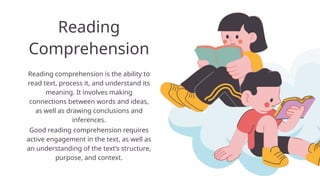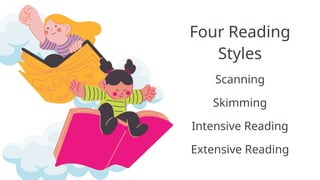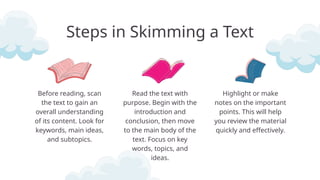Reading Styles.pptx for Children of Today
- 1. English Seven Reading Styles Rosa Maria Aguado
- 2. Learning Outcomes The students should be able to identify different types of reading styles. The students should be able to compare and contrast different reading styles. The students should be able to analyze the impact of reading styles on comprehension. 01 02 03
- 3. Opening Activity Find a pair in the classroom and ask the questions below about their reading habits and reading experiences. When was the last time you read? What was it about? 01 Do you read something about the product that you want to buy? 02 How do you know when a book from a bookstore is worth buying? 03 How do you get information from a book if you have little time? 04
- 4. Reading Comprehension Reading comprehension is the ability to read text, process it, and understand its meaning. It involves making connections between words and ideas, as well as drawing conclusions and inferences. Good reading comprehension requires active engagement in the text, as well as an understanding of the textŌĆÖs structure, purpose, and context.
- 5. It helps us to build on our existing knowledge and develop our critical thinking skills. It increases our vocabulary and improves our writing and speaking abilities. Why do we need to comprehend? It enables us to extract and comprehend meaningful information from the text. Reading comprehension helps us better understand the written word and how to effectively communicate with others.
- 7. The use of context clues helps the reader to understand unfamiliar words. Make sure you discuss the meaning of new words based on the surrounding text. It is a good idea to create a word journal or flashcards for new vocabulary. This can be used later for reinforcement. Vocabulary Development
- 8. Steps in Skimming a Text Before reading, scan the text to gain an overall understanding of its content. Look for keywords, main ideas, and subtopics. Read the text with purpose. Begin with the introduction and conclusion, then move to the main body of the text. Focus on key words, topics, and ideas. Highlight or make notes on the important points. This will help you review the material quickly and effectively.
- 9. Scanning Scanning reading is a reading technique that involves quickly skimming a text in order to locate specific information. It is used when the reader knows what they are looking for and need to find it quickly. Scanning reading requires the reader to skim the text in order to quickly identify the desired information.
- 10. Steps in Scanning a Text Take a few moments to read the title, introduction, and any headings or graphics. Make a quick prediction about the topic or the main idea of the text. Read the material carefully and look for key words or ideas. Take notes as you go along to help you remember and understand the material. After you have read and taken notes, summarize the material in a few sentences or bullet points. This will help you remember the main points and make sure that you have accurately understood the material.
- 11. Intensive Reading Intensive reading is a method of reading that is focused and in- depth. It involves reading text carefully and slowly, paying attention to details, and looking up unfamiliar words and concepts. Intensive reading is typically used to gain a deeper understanding of the text or to understand a particular concept.
- 12. Why Read Intensively? Intensive reading helps to improve comprehension by forcing readers to slow down and analyze the text in greater detail. This allows for a deeper understanding of the material. Intensive reading encourages critical thinking by allowing readers to question the text and draw their own conclusions. This helps readers to think more deeply. Intensive reading can also help to improve a personŌĆÖs vocabulary. By reading more challenging material, readers are exposed to unfamiliar words and concepts that they may not have encountered.
- 13. Extensive Reading Extensive reading is a method of language learning that involves a large amount of reading of authentic materials, such as novels, magazines, newspapers, and other texts. The goal of extensive reading is to help learners to become fluent in a language and to increase their knowledge of the language.
- 14. Why Read Extensively? Extensive reading allows students to develop their reading proficiency and expand their vocabulary. With regular practice, students become more familiar with the structure of written texts and this helps them to better comprehend what they read. By reading a variety of texts, students become more interested in reading and develop a greater appreciation for the activity. This encourages them to read more and even seek out new texts.
- 15. Reading is a journey... and the books are the wings that will take you there.
- 16. Resources Page
















